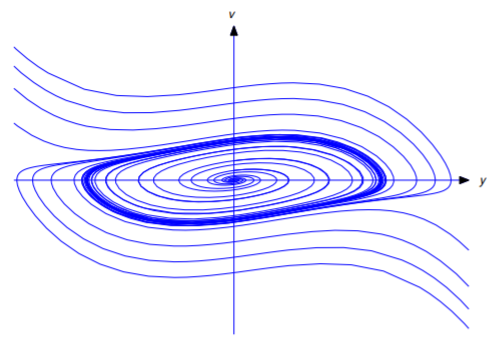4.4E: Autonomous Second Order Equations (Exercises)
- Page ID
- 18323
Q4.4.1
In Exercises 4.4.1-4.4.4 find the equations of the trajectories of the given undamped equation. Identify the equilibrium solutions, determine whether they are stable or unstable, and plot some trajectories.
1. \(y''+y^3=0\)
2. \(y''+y^2=0\)
3. \(y''+y|y|=0\)
4. \(y''+ye^{-y}=0\)
Q4.4.2
In Exercises 4.4.5–4.4.8 find the equations of the trajectories of the given undamped equation. Identify the equilibrium solutions, determine whether they are stable or unstable, and find the equations of the separatrices (that is, the curves through the unstable equilibria). Plot the separatrices and some trajectories in each of the regions of Poincaré plane determined by them.
5. \(y''-y^3+4y=0\)
6. \(y''+y^3-4y=0\)
7. \(y''+y(y^2-1)(y^2-4)=0\)
8. \(y''+y(y-2)(y-1)(y+2)=0\)
Q4.4.3
In Exercises 4.4.9–4.4.12 plot some trajectories of the given equation for various values (positive, negative, zero) of the parameter a. Find the equilibria of the equation and classify them as stable or unstable. Explain why the phase plane plots corresponding to positive and negative values of a differ so markedly. Can you think of a reason why zero deserves to be called the critical value of \(a\)?
9. \(y''+y^2-a=0\)
10. \(y''+y^3-ay=0\)
11. \(y''-y^3+ay=0\)
12. \(y''+y-ay^3=0\)
Q4.4.4
In Exercises 4.4.13-4.4.18 plot trajectories of the given equation for \(c = 0\) and small nonzero (positive and negative) values of \(c\) to observe the effects of damping.
13. \(y''+cy'+y^3=0\)
14. \(y''+cy'-y=0\)
15. \(y''+cy'+y^3=0\)
16. \(y''+cy'+y^2=0\)
17. \(y''+cy'+y|y|=0\)
18. \(y''+y(y-1)+cy=0\)
Q4.4.5
19. The van der Pol equation
\[y''-\mu(1-y^2)y'+y=0, \tag{A}\]
where \(\mu\) is a positive constant and \(y\) is electrical current (Section 6.3), arises in the study of an electrical circuit whose resistive properties depend upon the current. The damping term \(-\mu(1-y^2)y'\) works to reduce \(|y|\) if \(|y|<1\) or to increase \(|y|\) if \(|y|>1\). It can be shown that van der Pol’s equation has exactly one closed trajectory, which is called a limit cycle. Trajectories inside the limit cycle spiral outward to it, while trajectories outside the limit cycle spiral inward to it (Figure [figure:4.4.16}). Use your favorite differential equations software to verify this for \(\mu=.5,1.1.5,2\). Use a grid with \(-4<y<4\) and \(-4<v<4\).

20. Rayleigh’s equation,
\[y''-\mu(1-(y')^2/3)y'+y=0\]
also has a limit cycle. Follow the directions of Exercise 4.4.19 for this equation.
21. In connection with Equation 4.4.16, suppose \(y(0)=0\) and \(y'(0)=v_0\), where \(0<v_0<v_c\).
- Let \(T_1\) be the time required for \(y\) to increase from zero to \(y_{\max}=2\sin^{-1}(v_0/v_c)\). Show that \[{dy\over dt}=\sqrt{v_0^2-v_c^2\sin^2y/2},\quad 0\le t<T_1. \tag{A}\]
- Separate variables in (A) and show that \[T_1=\int_0^{y_{\max}}{du\over\sqrt{v_0^2-v_c^2\sin^2u/2}} \tag{B}\]
- Substitute \(\sin u/2=(v_0/v_c)\sin\theta\) in (B) to obtain \[T_1=2\int_0^{\pi/2}{d\theta\over\sqrt{v_c^2-v_0^2\sin^2\theta}}. \tag{C}\]
- Conclude from symmetry that the time required for \((y(t),v(t))\) to traverse the trajectory \[v^2=v_0^2-v_c^2\sin^2y/2\] is \(T=4T_1\), and that consequently \(y(t+T)=y(t)\) and \(v(t+T)=v(t)\); that is, the oscillation is periodic with period \(T\).
- Show that if \(v_0=v_c\), the integral in (C) is improper and diverges to \(\infty\). Conclude from this that \(y(t)<\pi\) for all \(t\) and \(\lim_{t\to\infty}y(t)=\pi\).
22. Give a direct definition of an unstable equilibrium of \(y''+p(y)=0\).
23. Let \(p\) be continuous for all \(y\) and \(p(0)=0\). Suppose there’s a positive number \(\rho\) such that \(p(y)>0\) if \(0<y\le \rho\) and \(p(y)<0\) if \(-\rho\le y<0\). For \(0<r\le\rho\) let
\[\alpha(r)=\min\left\{\int_0^r p(x)\,dx,\ \int_{-r}^0 |p(x)|\,dx\right\} \mbox{\quad and \quad} \beta(r)=\max\left\{\int_0^r p(x)\,dx,\ \int_{-r}^0 |p(x)|\,dx\right\}.\]
Let \(y\) be the solution of the initial value problem
\[y''+p(y)=0,\quad y(0)=v_0,\quad y'(0)=v_0,\]
and define \(c(y_0,v_0)=v_0^2+2\int_0^{y_0}p(x)\,dx\).
- Show that \[0<c(y_0,v_0) <v_0^2+2\beta(|y_0|)\mbox{\quad if \quad} 0<|y_0|\le\rho.\]
- Show that \[v^2+2\int_0^y p(x)\,dx=c(y_0,v_0),\quad t>0.\]
- Conclude from (b) that if \(c(y_0,v_0)<2\alpha(r)\) then \(|y|<r,\ t>0\).
- Given \(\epsilon>0\), let \(\delta>0\) be chosen so that \[\delta^2+2\beta(\delta)<\max\left\{\epsilon^2/2,2\alpha(\epsilon/\sqrt2) \right\}.\] Show that if \(\sqrt{y_0^2+v_0^2}<\delta\) then \(\sqrt{y^2+v^2}<\epsilon\) for \(t>0\), which implies that \(\overline y=0\) is a stable equilibrium of \(y''+p(y)=0\).
- Now let \(p\) be continuous for all \(y\) and \(p(\overline y)=0\), where \(\overline y\) is not necessarily zero. Suppose there’s a positive number \(\rho\) such that \(p(y)>0\) if \(\overline y<y\le \overline y+\rho\) and \(p(y)<0\) if \(\overline y-\rho\le y<\overline y\). Show that \(\overline y\) is a stable equilibrium of \(y''+p(y)=0\).
24. Let \(p\) be continuous for all \(y\).
- Suppose \(p(0)=0\) and there’s a positive number \(\rho\) such that \(p(y)<0\) if \(0<y\le \rho\). Let \(\epsilon\) be any number such that \(0<\epsilon<\rho\). Show that if \(y\) is the solution of the initial value problem \[y''+p(y)=0,\quad y(0)=y_0,\quad y'(0)=0\] with \(0<y_0<\epsilon\), then \(y(t)\ge\epsilon\) for some \(t>0\). Conclude that \(\overline y=0\) is an unstable equilibrium of \(y''+p(y)=0\).
- Now let \(p(\overline y)=0\), where \(\overline y\) isn’t necessarily zero. Suppose there’s a positive number \(\rho\) such that \(p(y)<0\) if \(\overline y<y\le \overline y+\rho\). Show that \(\overline y\) is an unstable equilibrium of \(y''+p(y)=0\).
- Modify your proofs of (a) and (b) to show that if there’s a positive number \(\rho\) such that \(p(y)>0\) if \(\overline y-\rho\le y<\overline y\), then \(\overline y\) is an unstable equilibrium of \(y''+p(y)=0\).


